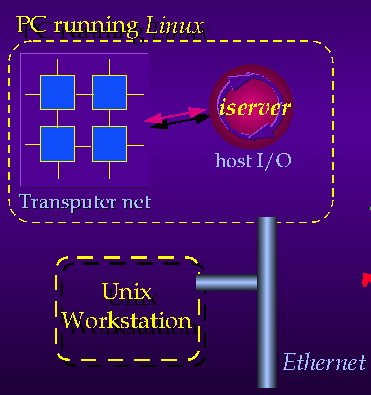
iserver on New Platforms: Linux
What is Linux?
Linux is a Unix "clone" for Intel 384/486-based computers. Despite being completely free, it has all the features one has come to expect from a modern Unix implementation (X windows, TCP/IP networking, NFS, NIS, Emacs, etc...) A PC running Linux loses its lowly "DOS-box" status and joins the ranks of "real machines"...
Interfacing the Transputer Board
A Linux device driver for the Inmos B008 transputer motherboard is has been written (by Christoph Niemann, niemann@swt.ruhr-uni-bochum.de). The current version is reported to work almost "perfectly" with the B008 board. The basic transputer interface is shown in the following figure.

A PC hosting the transputer network runs Linux complete with the B008 device driver and a full TCP/IP installation. A user at any workstation can then execute an "rlogin" to the PC, and run iserver under Linux. A Linux port of iserver already exists, and comes bundled with the B008 driver package. (Since Linux is a 32-bit operating system, there are no special problems involved in porting iserver to it, unlike the OSF1/AXP case.)
Advantages
A Linux solution to the transputer interfacing problem would be ideal, for reasons already mentioned:
- faster i/o between pc and trans net (bw x 2)
- doesn't "look like a pc"
- iserver already compiled, works nicely
Problems
-our board is not a b008...tmb16 -b008 compatible mode...
the sources
Future Suggestions
-would be nice if can port ncs... nice sol'n -best installation is Slackware comparisons potential probs: - newest version of "next generation dvel tools" don't support native comp - if wanted to upgrade to new comp wouldn't be able to use current comp/dev setup...would have to sit at PC for that mind you the runtime iface would still work - the fact that new icc has several nice features makes this all the more frustrating... software through-routing, dynamic function loading, inlining of channel communication code, etc etc
References
- Linux FAQ
- TMB16 hardware reference
- C012 link switch datasheet (Inmos)